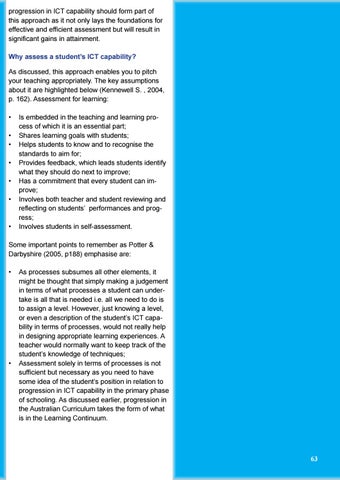progression in ICT capability should form part of this approach as it not only lays the foundations for effective and efficient assessment but will result in significant gains in attainment. Why assess a student’s ICT capability? As discussed, this approach enables you to pitch your teaching appropriately. The key assumptions about it are highlighted below (Kennewell S. , 2004, p. 162). Assessment for learning: • Is embedded in the teaching and learning process of which it is an essential part; • Shares learning goals with students; • Helps students to know and to recognise the standards to aim for; • Provides feedback, which leads students identify what they should do next to improve; • Has a commitment that every student can improve; • Involves both teacher and student reviewing and reflecting on students’ performances and progress; • Involves students in self-assessment. Some important points to remember as Potter & Darbyshire (2005, p188) emphasise are: • As processes subsumes all other elements, it might be thought that simply making a judgement in terms of what processes a student can undertake is all that is needed i.e. all we need to do is to assign a level. However, just knowing a level, or even a description of the student’s ICT capability in terms of processes, would not really help in designing appropriate learning experiences. A teacher would normally want to keep track of the student’s knowledge of techniques; • Assessment solely in terms of processes is not sufficient but necessary as you need to have some idea of the student’s position in relation to progression in ICT capability in the primary phase of schooling. As discussed earlier, progression in the Australian Curriculum takes the form of what is in the Learning Continuum.
63











